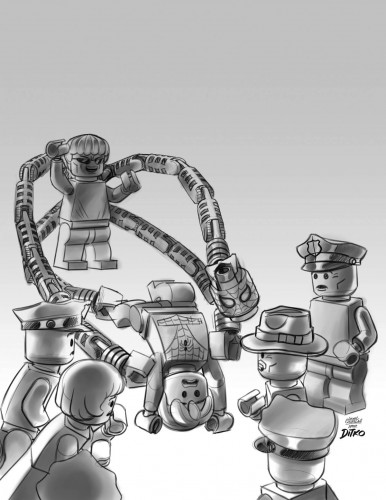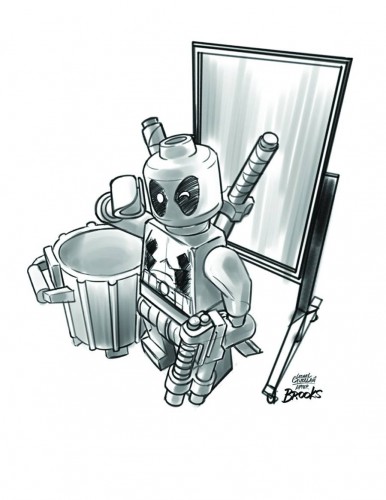With the first of the upcoming Marvel LEGO Variant Covers set to drop this week with X-men #5 and Mighty Avengers #1, we thought it might be a good idea to go over some of the details on how these variant covers work. I’m also putting all of the covers in this post as a sort of all in one gallery to keep track of the issues for those interested. There are five of the forty two missing at this point, but I will add them to this post when they pop up. If you collect comics you probably know all this already, anyone for whom comics is not their usual collectable may find this helpful. One thing is certain in both cases, it’s going to cost you.
It’s easy to vilify companies that create exclusive products in limited quantities because obviously, they hate you and don’t want to take your money. Looking past the deep seething hatred they have for their consumers it often times turns out that they are (apparently) running a business and their evil actions allow them to continue making money. Just about everyone makes exclusives these days and it doesn’t matter what it is they make whether it’s toys, comics, posters, CD’s (yeah, they still exist) or even vacuum cleaners. Some people will buy anything with the words “Limited” or “Special Edition” on them and companies cash in on this just the same as consumers will take advantage of those companies should the opportunity arise.
Over the years the comic book industry has tried just about everything. Bagging the comics with other collectable goodies, foil covers, lenticular covers, holograms, chromium covers, embossing. You name it. There was a period where every publisher was falling all over themselves to get celebrities, be they writers or otherwise, to put their names on original creations, hoping for the next big hit. One thing that has proven to be a huge success (for Marvel at least) is variant covers. There are all types of variant covers and some of those I mentioned still pop up from time to time, but it’s mostly a throwback. The main comic variants that remain fairly steady are the ones done by other artists that don’t normally work on the book (or are higher profile), blank covers that you can have your favourite artist whip something special up for you, and sketch variants.
Variants are a big, BIG business for the retailers and some can make some serious coin from these rewards, or at least offset their costs in getting them. Variants aren’t exclusive to Marvel, but they have made it a bigger industry then most. They aren’t specifically trying to make it hard for you to get your hands on them all, but they aren’t trying to make it easy either. It’s not uncommon to see a bunch of variants listed on the inside of a cover: A, B, C, C sketch, D, RI-A, RI-B & RI-B sketch, etc, etc.
That RI cover on my made up checklist stands for “retailer incentive†and that’s exactly what it is. They are a reward to the comic shop for buying a certain number of books and they can start as low as 1:1, or otherwise known as “50/50”. IDW and Dynamite do this quite often and if you’re quick you can pick up both covers off the shelf. 50/50 is the easy one, if your comic shop orders two copies of a book, they get one of each. Another common level is 1:4 or 1:5, meaning for every four or five copies they buy, they get a variant cover. Boom, simple. They can then either keep the book (if the shop owner is a collector), sell the books at a regular price (to valued customers, passing the reward on) or sell the book for a couple extra bucks which can help offset any regular copies of the book they couldn’t sell or just making a profit. That is why they have a business after all. This incentive is a way the comic publishers can push a book and in the end it is all about moving units for them, that’s how they make their money. If they really want to push a book, they’ll create multiple variant incentives at different ordering levels. 1 in 10, 1 in 15, 1 in 25, 1 in 50 and 1 in 100. The LEGO sketch variants are probably in the 1:50 or 1:100 range given the prices they command where the regular color covers are somewhere in the lower range.
There are other distribution levels and even shop exclusives for high profile comic retailers like Midtown in New York or even Silver Snail in Toronto, but if you don’t live near them then the only option is to try and by those ultra exclusive variants online. Now, these incentives are usually not a reality for smaller comic shops. They need to order based on what they know they can move and will rarely take a risk at buying far more books for chance to make a bit of extra. So if your main source of comics is a small shop then you would rarely see any variants and once again you’re left to the online market to try and get any you want. That is the house that I live in. My local shop can’t move the levels of comics that they would need to in order to get these variants and so they don’t order inflated amounts. That’s just smart business, but it leaves me looking elsewhere for my variant covers. Boo hoo, right?
These incentives are a factor in a comic shop deciding how many issues they will order. If the cost of Mighty Avengers #1 is $2 for the retailer and they order 100 copies there is a danger they will only sell a quarter of that at $3 each making only $75 0f their $200 investment. Add in a few incentives and they can make their money back even though they end up stuck with a low selling book. If the book takes off, they can sell those back issues and they make a tidy profit. If not, selling a 1 in 100 cover for $80, a 1 in 50 for $40 and a 1 in $25 for $15 means that they’ve made their initial investment back having sold only a quarter of the books. Selling those three extra books netted them a $10 profit and they can dump those extra issues at whatever price they want and make even more. These prices are just rough estimates because a number of factors can influence the price, including artists, popularity of the book and even the possibility of it appealing to a crossover fan base. Like us. The prices vary from retailer to retailer, but the numbers are usually fairly consistent.
As an example, Issue #1 of The New Adventures of Clutch Powers has variants at the following: 1:5, 1:10, 1:25, 1:50, and 1:100. Now Clutch Powers is a huge seller so my local shop From Bricks To Backissues buys a whopping 200 copies, because the owner prefers to buy huge amounts in a “go big or go home” ideology.
- 200 issues at $2 each = $400 cost
- 40 1:5 variants sell for $7 each = $280
- 20 1:10 variants sell for $15 each = $300
- 8 1:25 variants sell for $30 each = $240
- 4 1:50 variants sell for $60 each = $240
- 2 1:100 variant sells for $80 each = $160
- The remaining 126 copies with the standard cover sell for $3 = $378
- $1598 sales – $400 cost = $1198 profit
These numbers assume all the issues sell and the prices are averages at best based on what I’ve seen, but you get the idea. These covers help keep the doors open at many comic shops and that’s a good thing. Period. Of course they’d really only sell one copy of that book… well, possibly more if I could get the variants at slightly better prices and they looked cool (which they totally would!).
Marvel makes the variant covers for the retailers to attempt to get them to buy more copies of the book, the retailers sell them at a higher price based on rarity and that helps offset the cost of the book, hopefully remain in the black and the collectors with the extra cash to spend on shiny variant covers get a pretty picture to look at. Everybody wins. If you can’t afford the variants, you can still buy a regular copy of the book and other than the cover it’s exactly the same book. It’s not cheap, but if you make the decision to collect variants you have to take the fact that you’ll be spending a lot of money into account and how much money can fluctuate wildly. This is not an unfair practice, it’s just business. It may be disappointing that you won’t get a variant due to availability or expense, but that’s all part of the game. If it bothers you, don’t play. I came to terms with the fact that I won’t be able to get every comic variant I want a long time ago. I could probably afford them if I cut back on other expenditures like LEGO and video games, but I just don’t want to spend that much on a comic book in most cases. That’s the important question, How much do you really want this cover.
We plan on posting weekly about the issues that will be released that Wednesday. Consider it a reminder for those who really want to spend the time and money to track all of these down and for the rest of us it’ll just be another chance to take a look at the nifty covers. We’ll also give links to the issues on some of our favourite comic shops that sell online for those that don’t have access to a comic shop that would carry these. Midtown Comics is a favourite of mine and I’ve made a point to go there both times I visited NY. I even dragged Ace and Don there on the last trip. Midtown currently has X-men #5 and Mighty Avengers #1 up for pre-order. They offer free shipping on orders of $75 or more and don’t charge tax unless you live in New York. They even offer a 15% discount off of their regular prices. Full disclosure: we are NOT an affiliate of Midtown Comics:
Midtown Comics
- Mighty Avengers #1 LEGO Variant Color Cover $17.00, down from $20
- Mighty Avengers #1 LEGO Variant Sketch Cover $63.75, down from $75
- X-men #5 LEGO Variant Color Cover $17.00, down from $20
- X-men #5 LEGO Variant Sketch Cover $63.75, down from $75
Bottom line: if you were planning on getting both color and sketch variant covers of all of the comics, you’re looking at spending anywhere from $1,600 to $2,000 or more depending on whatever the final price is set by the retailer(s) you buy from. Unless you have piles of disposable income or are just crazy for LEGO and comic crossovers, you’re better off putting the money towards LEGO sets.
We’ve arranged the gallery below in order of release date, but keep in mind that these dates are subject to change at any time and “any time” usually means when you show up at the store and they just found out the book didn’t ship.
Release date: September 11th, 2013
Release Date: September 18th, 2013
Release Date: September 25th, 2013
Release Date: October 2nd, 2013
Release Date: October 9th, 2013
Release Date: October 16th, 2013
Release Date: October 23rd, 2013
Awaiting Updated Release Dates:
Questions? Let us know in the forum thread.




















































